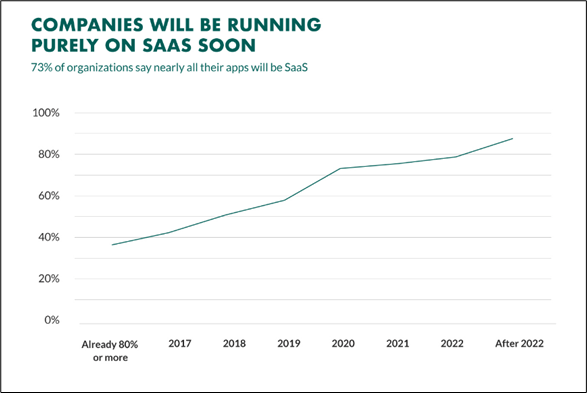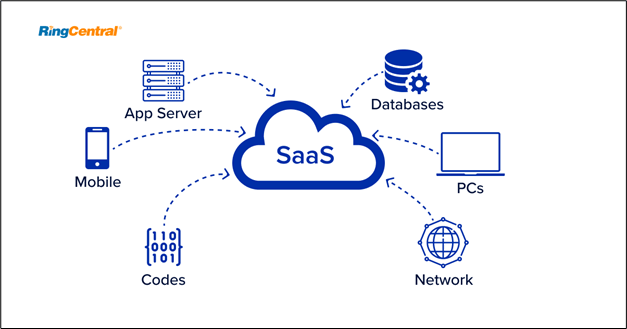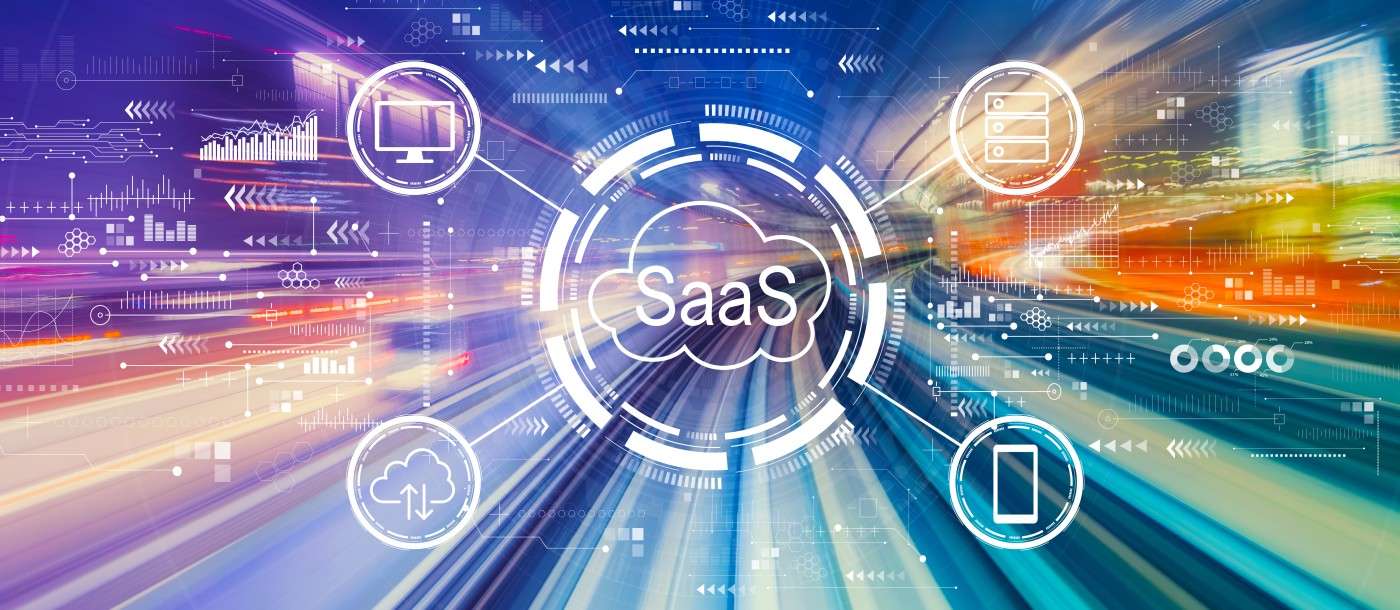Contents
What is SaaS (Software as a Service)?
Software as a service (SaaS) is a kind of software distribution model where a cloud provider hosts applications and makes those applications available to end-users over an Internet-enabled network. An independent software vendor (ISV) can contract with a third-party cloud provider to host the software application. The ability to access software through the Internet helps you free yourself from the complications of hardware and software management. SaaS, along with Platform as a Service (PaaS) and Infrastructure as a Service (IaaS), are the three major cloud computing categories.
Why do we need SaaS?
Since the early 2000s, SaaS has been an economical alternative to conventional IT, where you build or buy IT infrastructure, install software, configure applications, and employ IT personnel for maintenance. SaaS helps an organisation save significantly in multiple ways. It enables an organisation to do away with purchase/installation costs as well as regular expenses such as upgrades and maintenance. An organisation no longer needs to incur expenditure related to hardware acquisition, software licensing, support and installation. Many companies are recognising these benefits and are moving quickly to SaaS-based software infrastructure.

How does SaaS work?
SaaS uses an on-demand, cloud delivery model. A software provider either hosts the application and associated data using its own servers, computing and networking resources, and databases, or an ISV hires a cloud provider to host the application in the data centre of the provider. SaaS providers allow network access to customers, which helps them access software applications. A customer’s data is either stored on the cloud or locally. An application programming interface (API) enables the integration of SaaS with other software already operating as part of the system.

SaaS Architecture
SaaS applications utilise a multi-tenant approach, i.e., a single instance of a SaaS application runs on host servers. The application runs on a single configuration and version across all the tenants or customers. Although different customers run on the same cloud instance with a common platform and infrastructure, the data of all those customers remains segregated.
A multi-tenant architecture also means that the cloud service provider manages the maintenance, updates, and bug fixes faster and in a more efficient manner. Instead of implementing changes in various instances, engineers make the essential changes for all the customers by maintaining one shared instance. In addition, multi-tenancy helps in making a larger pool of resources available to a bigger group of people, without compromising on important cloud functions like security, privacy, and speed.
What are the benefits of SaaS?
SaaS provides an interesting and cost-effective alternative to software installation in a business environment. The benefits of utilising SaaS in a business include:
- No initial investment and payment flexibility: SaaS operates on a pay-as-you-go model with no initial investment. Therefore, an organisation does not need to purchase and install a permanent IT infrastructure. Instead, they subscribe to a package and pay an annual or monthly fee as per usage. In this way, businesses have greater control over their expenditure. Since expenses are foreseeable, they can be terminated when necessary.
- Integration and scalability: SaaS solutions are present in scalable cloud environments and are integrated with other SaaS products. The SaaS provider will take care of the server capacity planning for a new SaaS offering. Also, there is the flexibility to scale SaaS usage up and down according to requirements.
- Accessibility: Since data is stored in the cloud, a user can access it from anywhere and at any time. This means that any computer or laptop connected to the Internet, a mobile iOS or Android phone device has access to SaaS applications. In the event of device failure, the backup exists, and it can be accessed from a different device.
- Automatic updates: Instead of purchasing new software, SaaS customers can bank upon SaaS providers to perform patch management and auto updates. This also decreases the burden of inhouse resources.
- Ease of use: It is convenient for enterprises to use SaaS offerings because of their inbuilt best practices. One need not be an IT expert to make the most out of such tools. Therefore, businesses can channelize their energies towards activities that matter more.
What are the challenges of SaaS?
Since businesses depend on outside vendors to fulfil their SaaS requirements, there are certain risks and challenges associated with its usage.
- Loss of control: Businesses depend on external service providers for maintenance, distribution, and management of software. Unanticipated service disruptions, unwanted changes in service offerings, or an unexpected security breach hamper the ability to fully utilise the SaaS service. Therefore, SaaS customers must understand the service-level agreement (SLA) of their SaaS provider and ensure that it is applied.
- No control on updates: If a SaaS provider offers a new version of any software, it is rolled out to all the customers, whether they want it or not. Therefore, companies need to be prepared beforehand to allocate extra time for training resources.
- Difficulty in changing vendors: To change vendors, customers need to migrate data in large quantities. Some of the vendors use proprietary technologies. This adds to the complexity of data transfer between cloud providers. It also leads to unnecessary vendor lock-in since a customer can not easily transition between service providers.
- Data security: On-cloud storage of data itself implies reposing a lot of faith in the service providers to ensure that the data is not misused at any cost.
SaaS for Security and Privacy.
The cybersecurity risks connected with SaaS are different from those of conventional software. When it comes to privacy and security, enterprises still have concerns about SaaS offerings despite large-scale adoption of cloud models. These concerns are:
- Data privacy
- Security monitoring
- Key management and encryption
- Identity and access management (IAM)
- Incident response
- Lack of proper integration into company-specific environments
- Third-party costs to mitigate risk associated with SaaS security
SaaS vs. IaaS vs. PaaS
SaaS, IaaS, and PaaS are the three important cloud service models that provide their own hosted data centre resources to customers over a connected network. These three models differ in terms of completeness. SaaS products are completely managed applications. IaaS is extensively focused on outsourcing data centre resources. PaaS offers a development platform as well as other tools hosted by the data centre of the provider.
SaaS application users don’t need to download any software or manage IT infrastructure. They also do not deal with software management aspects in any form. The vendor takes care of maintenance, security, support, upgrades, as well as other aspects of software management.
IaaS is suitable for organisations that intend to outsource their computer resources and data centres to a cloud provider. IaaS providers host infrastructure components like networking hardware, storage, and servers as well as virtualization resources. However, organisations that deploy IaaS services still need to manage their data use, operating systems (OSes), and applications.
PaaS(Platform as a Service) provides a resource framework to the in-house developers of an organisation. This hosted platform facilitates the creation of customised applications by developers. The organisations that use PaaS services do not manage their OSes, but still must manage their data use and applications.
FAQs
1. What is Xaas (Everything as a Service)?
Previously, only cloud technology was there. Therefore, cloud service providers offer various cloud services to their customers. However, with the emergence of the new concept of Everything as a Service (XaaS), anything can be a service by utilising remote access and cloud computing. In line with the concept, different technologies, tools, and services are provided to the end-customers ‘as a service’. Earlier, companies used to purchase licensed products. XaaS simplifies businesses as they pay only for what they need. Everything as a Service is also referred to as Anything as a Service.
2. What are some of the most famous SaaS examples?
Below are the examples of a few famous SaaS models:
a. Amazon Web Services (AWS): AWS, a subsidiary of Amazon, has more than 1 million users. With more than 150 cloud-based services to offer, AWS provides individuals and businesses with all the required tools such as machine learning (ML), robotics, business applications, Internet of Things (IoT), database, security, blockchain and storage.
b. HubSpot: An important SaaS tool that provides an all-in-one suite of Customer Relationship Management (CRM), Content Management System (CMS), services software, as well as sales and marketing services to businesses. It helps businesses at every stage of the marketing funnel, from awareness to retention.
c. Salesforce:A complete CRM suite that lets businesses collect, store, access, monitor, and analyse customer data using a single dashboard.
d. G Suite: A Google Cloud SaaS application that includes many cloud-based apps such as Gmail, Hangouts, Forms, Docs, Google Drive, Calendar, Vault, and Slides as well as many other applications.
e. Canva: A freely available online design tool with a drag-and-drop interface that helps in creating content for social media. It includes several templates to help a user get started immediately. One can easily create book covers, flyers, social media posts, invitation cards, blog post images, posters, graphs, and presentations.













